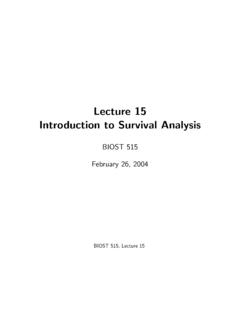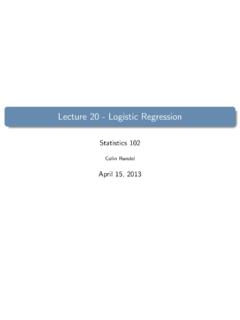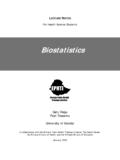Transcription of Introduction to Machine Learning Lecture notes
1 CSE176 Introduction to Machine Learning Lecture notes Miguel A . Carreira-Perpin a n EECS, University of California, Merced November 28, 2016. These are notes for a one-semester undergraduate course on Machine Learning given by Prof. Miguel A . Carreira-Perpin a n at the University of California, Merced. The notes are largely based on the book Introduction to Machine Learning by Ethem Alpayd n (MIT Press, 3rd ed., 2014), with some additions. These notes may be used for educational, non-commercial purposes. c 2015 2016 Miguel A . Carreira-Perpin a n 1 Introduction What is Machine Learning (ML)? Data is being produced and stored continuously ( big data ): science: genomics, astronomy, materials science, particle accelerators.. sensor networks: weather measurements, traffic.. people: social networks, blogs, mobile phones, purchases, bank transactions.. etc. Data is not random; it contains structure that can be used to predict outcomes, or gain knowl- edge in some way.
2 Ex: patterns of Amazon purchases can be used to recommend items. It is more difficult to design algorithms for such tasks (compared to, say, sorting an array or calculating a payroll). Such algorithms need data. Ex: construct a spam filter, using a collection of email messages labelled as spam/not spam. Data mining: the application of ML methods to large databases. Ex of ML applications: fraud detection, medical diagnosis, speech or face recognition.. ML is programming computers using data (past experience) to optimize a performance criterion. ML relies on: Statistics: making inferences from sample data. Numerical algorithms (linear algebra, optimization): optimize criteria, manipulate models. Computer science: data structures and programs that solve a ML problem efficiently. A model: is a compressed version of a database;. extracts knowledge from it;. does not have perfect performance but is a useful approximation to the data.
3 Examples of ML problems Supervised Learning : labels provided. Classification (pattern recognition): Face recognition. Difficult because of the complex variability in the data: pose and illumination in a face image, occlusions, glasses/beard/make-up/etc. Training examples: Test images: Optical character recognition: different styles, slant.. Medical diagnosis: often, variables are missing (tests are costly). 1. Speech recognition, Machine translation, biometrics.. Credit scoring: classify customers into high- and low-risk, based on their income and savings, using data about past loans (whether they were paid or not). regression : the labels to be predicted are continuous: Predict the price of a car from its mileage. Navigating a car: angle of the steering. Kinematics of a robot arm: predict workspace location from angles. if income > 1 and savings > 2. y = wx + w0. then low-risk else high-risk Savings Low-Risk y: price 2.
4 High-Risk Income 1 x: mileage Unsupervised Learning : no labels provided, only input data. Learning associations: Basket analysis: let p(Y |X) = probability that a customer who buys product X. also buys product Y , estimated from past purchases. If p(Y |X) is large (say ), associate X Y . When someone buys X, recommend them Y . Clustering: group similar data points. Density estimation: where are data points likely to lie? Dimensionality reduction: data lies in a low-dimensional manifold. Feature selection: keep only useful features. Outlier/novelty detection. Semisupervised Learning : labels provided for some points only. Reinforcement Learning : find a sequence of actions (policy) that reaches a goal. No supervised output but delayed reward. Ex: playing chess or a computer game, robot in a maze. 2. 2 Supervised Learning Learning a class from examples: two-class problems We are given a training set of labeled examples (positive and negative) and want to learn a classifier that we can use to predict unseen examples, or to understand the data.
5 Input representation: we need to decide what attributes (features) to use to describe the input patterns (examples, instances). This implies ignoring other attributes as irrelevant. Hypothesis class of rectangles training set for a family car (p1 price p2 ) AND (e1 engine power e2 ). where p1 , p2 , e1 , e2 R. x2: Engine power x2: Engine power e2 C. e1. x2t x1t p1 p2. x1: Price x1: Price Training set: X = {(xn , yn )}N. n=1 where xn R. D. is the nth input vector and yn {0, 1} its class label. Hypothesis (model) class H: the set of classifier functions we will use. Ideally, the true class distribution C can be represented by a function in H (exactly, or with a small error). Having selected H, Learning the class reduces to finding an optimal h H. We don't know the true class regions C, but we can approximate them by the empirical error : N. X. E(h; X ) = I(h(xn ) 6= yn ) = number of misclassified instances n=1.
6 There may be more than one optimal h H. In that case, we achieve better generalization by maximizing the margin (the distance between the boundary of h and the instances closest to it). the hypothesis with the largest margin noise and a more complex hypothesis . x2.. h2. h1. x1. 3. Noise Noise is any unwanted anomaly in the data. It can be due to: Imprecision in recording the input attributes: xn . Errors in labeling the input vectors: yn . Attributes not considered that affect the label (hidden or latent attributes, may be unob- servable). Noise makes Learning harder. Should we keep the hypothesis class simple rather than complex? Easier to use and to train (fewer parameters, faster). Easier to explain or interpret. Less variance in the learned model than for a complex model (less affected by single instances), but also higher bias. Given comparable empirical error, a simple model will generalize better than a complex one.
7 (Occam's razor : simpler explanations are more plausible; eliminate unnecessary complexity.). Learning multiple classes With K classes, we can code the label as an integer y = k {1, .. , K}, or as a one-of-K. binary vector y = (y1 , .. , yK )T {0, 1}K (containing a single 1 in position k). One approach for K-class classification: consider it as K two-class classification problems, and minimize the total empirical error: N X. X K. E({hk }K. k=1 ; X ) = I(hk (xn ) 6= ynk ). n=1 k=1. where yn is coded as one-of-K and hk is the two-class classifier for problem k, , hk (x) {0, 1}. Ideally, for a given pattern x only one hk (x) is one. When no, or more than one, hk (x) is one then the classifier is in doubt and may reject the pattern. regression : polynomials of order 1, 2, 6. 3-class example ( solve for order 1: optimal w0 , w1 ). Sports car Engine power ? ? y: price Luxury sedan Family car Price x: milage 4.
8 regression Training set X = {(xn , yn )}N D. n=1 where the label for a pattern xn R is a real value yn R. In multivariate regression , yn Rd is a real vector. We assume the labels were produced by applying an unknown function f to the instances, and we want to learn (or estimate) that function using functions h from a hypothesis class H. Ex: H= class of linear functions: h(x) = w0 + w1 x1 + + wD xD = wT x + w0 . Interpolation: we learn a function h(x) that passes through each training pair (xn , yn ) (no noise): yn = h(xn ), n = 1, .. , N. Ex: polynomial interpolation (requires a polynomial of degree N 1 with N points in general position). regression : we assume random additive noise : y = h(x) + . N. 1 X. Empirical error: E(h; X ) = (yn h(xn ))2 = sum of squared errors at each instance. N n=1. Other definitions of error possible, absolute value instead of square. Occam's razor applies again.
9 A line with low enough error may be preferable to a parabola with a slightly lower error. Model selection and generalization Machine Learning problems (classification, regression and others) are typically ill-posed : the observed data is finite and does not uniquely determine the classification or regression function. In order to find a unique solution, and learn something useful, we must make assumptions (=. inductive bias of the Learning algorithm). Ex: the use of a hypothesis class H; the use of the largest margin; the use of the least-squares objective function. We can always enlarge the class of functions that can be learned by using a larger hypothesis class H (higher capacity, or complexity of H). Ex: a union of rectangles; a polynomial of order N . How to choose the right inductive bias, in particular the right hypothesis class H? This is the model selection problem.
10 The goal of ML is not to replicate the training data, but to predict unseen data well, , to generalize well. For best generalization, we should match the complexity of the hypothesis class H with the complexity of the function underlying the data: If H is less complex: underfitting. Ex: fitting a line to data generated from a cubic polynomial. If H is more complex: overfitting. Ex: fitting a cubic polynomial to data generated from a line. In summary, in ML algorithms there is a tradeoff between 3 factors: the complexity c(H) of the hypothesis class the amount of training data N. the generalization error E. so that as N , E . as c(H) , first E and then E . 5. Cross-validation Often used in practice to select among several hypothesis classes H1 , H2 , .. Divide the available dataset into three disjoint parts (say, 13 each): Training set: Used to train, , to fit a hypothesis h Hi.

![[Ablowitz, Fokas] Complex Variables - UCM FacultyWeb](/cache/preview/7/7/2/e/8/0/e/7/thumb-772e80e77b77db8dace963a7f9fc71a6.jpg)








